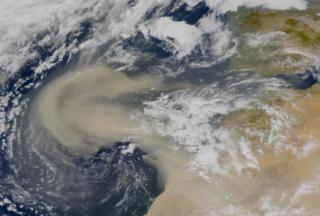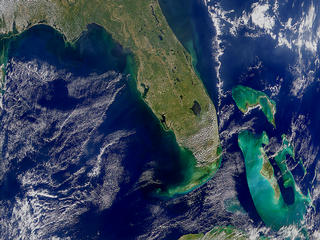Dust from Africa Leads to Large Toxic Algae Blooms in Gulf of Mexico, Study Finds
 |
 |
| African Dust | Toxic Florida Algae |
Saharan dust clouds travel thousands of miles and fertilize the water off the West Florida coast with iron, which kicks off blooms of toxic algae, according to a new study. The research was partially funded by a NASA grant as part of ECOHAB: Florida (Ecology and Oceanography of Harmful Algal Blooms), a multi-disciplinary research project designed to study harmful algae.
Toxic algal blooms, sometimes called red tides, have in the past killed huge numbers of fish, shellfish, marine mammals, birds, and can cause skin and respiratory problems in humans.
Each year iron from Saharan dust clouds is deposited in the waters off the West Florida coast. Once there, plant-like bacteria use the iron to set the stage for red tides. When iron levels go up, this bacteria, called Trichodesmium, 'fixes' nitrogen in the water, converting it to a form usable by other marine life. The addition of biologically usable nitrogen in the water makes the Gulf of Mexico a more likely environment for toxic algae to bloom.
"This is one of the first studies that quantitatively measured iron from the dust and tied it to red tides through Trichodesmium," said Jason Lenes, a graduate student at University of South Florida's College of Marine Science, and the lead author in the study. Lenes works under John J. Walsh, one of the principal investigators for ECOHAB, and one of the paper's coauthors. The research appears in the September issue of the scientific journal, Limnology and Oceanography.
Storm activity in the Sahara Desert region generates clouds of dust that originate from fine particles in the arid topsoil. Easterly trade winds carry the dust across the Atlantic Ocean and into the Gulf of Mexico. "Because iron is one of the most common elements in most soils, a certain percentage of the dust contains iron," said Lenes.
The study used satellite and ground based measurements to track large dust clouds leaving Africa on June 17, 1999. Lenes and his colleagues followed the clouds using data from the Advanced Very-High-Resolution Radiometer (AVHRR), an imager aboard the National Oceanic and Atmospheric Administration's (NOAA's) Polar Orbiting Environmental Satellites (POES).
The Saharan dust reached the West Florida shelf around July 1st, increasing iron concentrations in the surface waters by 300 percent. As a result, Trichodesmium counts shot up 10 times what they had been prior to this event. Through a complex process involving a special enzyme called nitrogenase, the Trichodesmium used the iron to convert nitrogen in the water to a form more usable for other marine life. In October, after a 300 percent increase of dissolved organic nitrogen, a huge bloom of toxic red algae (Karenia brevis) had formed within the study area, an 8,100 square mile region between Tampa Bay and Fort Myers, Florida.
Scientists have labored for several years in an effort to develop a reliable method to predict red tides, particularly because the results of these blooms can be both physically and economically devastating to a region.
"The West Florida shelf is a hot spot for fishing, aquaculture and tourism, all of which can be drastically affected by a surprise visit from a red tide," said Lenes.
Humans who swim in the Gulf can experience respiratory problems by breathing toxins from K. brevis that get in the air. Also, eating shellfish poisoned by red tides can lead to paralysis and memory problems. Around the Gulf of Mexico, scientists and others have recorded fish kills totaling in the millions and manatee deaths in the hundreds resulting from a single red tide bloom.
By using satellites to monitor dust arrivals and Trichodesmium blooms, Lenes said this research could lead to forecasting of red tides. "If you could predict when a red tide is coming, you could close beaches and fisheries ahead of time," Lenes said.
The paper was funded through a number of grants connected with the ECOHAB program. Other funding for this study included grants from the National Oceanic and Atmospheric Administration, the Office of Naval Research and the Environmental Protection Agency. The ECOHAB: Florida Mission is to better understand the factors involved in the occurrence and dispersal of Florida's predominant red tide algae, K. brevis, and to predict and manage harmful algal bloom events.